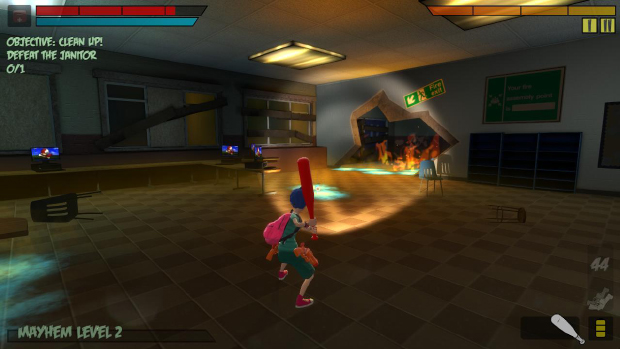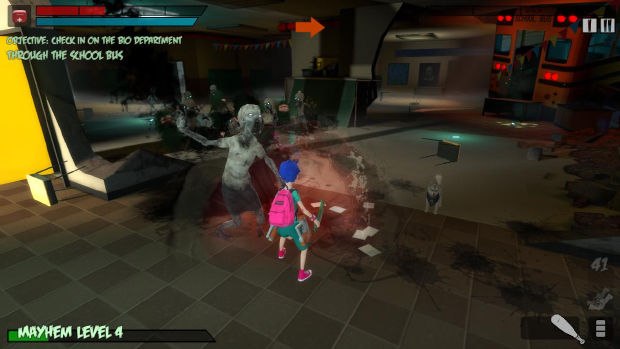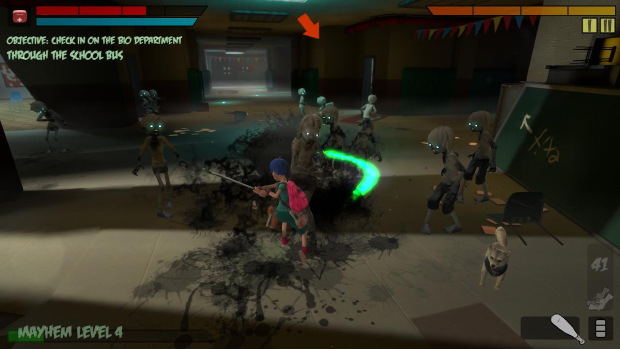Premature Evaluation: Zombie Playground
Baaaairns
Each week Marsh Davies tears into the unholy children of Early Access with a wiffle bat and comes back with any stories he can find and/or ends up as a brain-pan buffet. This week he’s played Zombie Playground, a thirdperson brawler set in a school.
Back in 2012, at least 3787 people looked at Jason Chan’s painting - a helter skelter, valiantly defended against hordes of undead tots by four equally pre-pubescent warriors wielding mops and bin-lids - and thought, “Wow! What if this was a game?” Of course, the question they should have been asking is, “Wow! What if this was an extremely rudimentary fulfilment of the Kickstarter promises?” But nonetheless, ask they did, and stump up cash they did, and for three years, these wide-eyed would-be zombie-botherers have continued to ask the same question, albeit with a decreasingly civil tone. Following long periods of silence, and tumult behind the scenes, development duties have shifted to a partnership of three other companies and now, finally, the backers have some sort of answer.
In fairness to the devs, they are quick to warn players that the game is “a true Beta”. In unfairness to the devs, beta is a big claim for the current status of Zombie Playground, and £11 is a big price, too. Beta suggests a feature-complete game in need of finesse. So far, Zombie Playground has an environment. It has enemies that respawn endlessly in that environment. And you can hit those enemies until they (or you) fall over - by way of a combat system that has some smarts but hasn’t yet been made to function entirely usefully within the rest of the game.
The one truly workable element of the game seems to be character customisation. I build a girl-child with a mop of striking blue hair, and a snazzy colour-contrasting outfit of neon pinks and greens that defies traditional gender stereotypes.
You can’t make black children. But you can have an AI dog!
Eventually, the XP you earn across your various sorties will be used to earn access to all this cosmetic stuff - which is currently freely available. It’s not yet clear why the XP system exists other than to defer access to this content - indeed, I don’t really understand what the structure of the game is to be. Do you just go to this environment, grind until you die, and then unlock new skirts? I’m doubtful this qualifies a game as an RPG. The devs’ notes do make reference to forthcoming “honest-to-goodness quests”, but I don’t know what that means. Currently, XP unlocks missions of the Kill 500 Zombies variety. Which I presume gives you more XP. Which allows you to unlock missions. I call this game design technique The Ouroboros of Fuck Off.
The starting mission is to Explore The School, which leads you back and forth across the environment from waypoint to waypoint, finally returning to the school gate where you first start. My dog and I are first tasked with congregating at the flagpole. Said congregation would be larger, but I can’t get the online co-op to work. As we scoot up, ghostly white-haired kids emerge from pools of bubbling black goo that have spontaneously manifested all around. Wielding the blade of a paper-cutter, I lay into them. Left-mouse-button delivers light attacks and right charges up an attack. Combos are based on timing rather than, er, combination: pause momentarily after one, two, or three light attacks and the weapon will flash. Attack again at that moment and you deliver a more powerful attack: a spin attack, a handy forward charge, or an AOE ground-pound. You can also switch to ranged weapons: I have a pair of nail guns, which feel piffling, and do little to halt the tides of enemies bounding towards me. Indeed, I’m not sure the combat system as a whole quite sits flush with the kind of messy and relentless melee challenge you typically face. The variety of close combat moves work really well against a handful of opponents, giving you crowd control and mobility, but the advantages of this are quickly outstripped by the sheer numbers you face. As enemies respawn nearby constantly, it’s usually easiest to just thrash light attacks: pausing to deliver a combo attack wastes an opportunity to stagger the foes that immediately threaten to do you damage.
As I move into the school’s main atrium, enemies start lobbing their brains at me - somehow they have an infinite supply - but there’s no interesting tactical solution to this, other than to move off to fight in more enclosed spaces, where enemies can’t pummel you at range. Since enemies respawn, it’s not like you have any reason to fight them if you don’t want to. There will only be more of them in a few seconds anyway.
The waypointer tells me to go upstairs and then tells me to go back downstairs again. I head off into some classrooms to the right of the atrium at the waypointer’s fickle behest. There are some nice touches to the environmental design, like the yellow school bus rammed askance through a wall, but this is generally a notably low-spec affair. At the technological level it struggles to do justice to Chan’s concept art, which conveys a crisp fidelity, even as it enlarges and caricatures. Here, meanwhile, the gaudy lighting and absence of shadows undermines the necessary familiarity of the setting. One area has giant mushrooms all over the place. Another has smashed, luminescing jam jars - not a staple horror trope with which I am familiar. Another is on fire. The fire looks bad. It is on bad fire.
I make the mistake of fighting an adult undead, prowling round the language school. She doesn’t react to any of my attacks so I’m not sure if I am damaging her, and though I dodge her swings, kiting her around for what feels like a long time, I eventually get snagged on some scenery and die in a few hits, the collision of which is ambiguous enough to elicit swearwords.
I try again and again, though there’s not a lot else to do other than die or complete the quest by hitting all the requisite waypoints (harder than it sounds, because the waypoint arrow is, at times, entirely unhelpful). You can choose one of two classes at present: the Bully character is slow and tanky, with two special moves on the number keys: a mighty stomp and a damage buff. The Rascal class, moves faster but falls quicker, coming equipped with a speed boost special and temporary invulnerability.
Levelling up over subsequent games, I unlock the final mission of the current build, which tasks me with fighting the janitor. The environment is now deserted. I am told I need to “make a mess”, presumably to lure the janitor out, and then, later, smash up the janitor’s mop bucket. I do this but no janitor emerges to counter my major dis against his janitation skills. Instead, the mission prompt tells me I now have to “clean up”. The game doesn’t seem to have any key bindings for such an action. I smash up some sinks, in the hope that the geysering water will wash away the black ick that pools on the floor in the toilets. It doesn’t. I wander around the school some more, but no one’s here. Eventually I concede that this is probably a bug and quit.
Even after three years, Zombie Playground is a long way from completion, and, it saddens me to say, a much greater distance still from capturing the imagined experience Jason Chan’s picture suggested. For one thing, that imagined experience probably has advanced character physics, dynamic shadows and a few more polygons. But, if you gently bludgeon the grandiose (and perhaps unrealistic) dreams inspired by the early concept art, it’s possible to accept that a dedicated team could massage Zombie Playground into an enjoyable sandbox romp in the estimated six months they have in Early Access. Right now, the Early Access debut is too formless to say whether that’s likely: a few more updates to give some rigidity to its structure and a sense of purpose to the play and we’ll know for sure if the hope’s dead or whether it’s just been napping.
Zombie Playground is available from Steam for £11. I played version with the Build ID 706718 on 31/07/2015.






